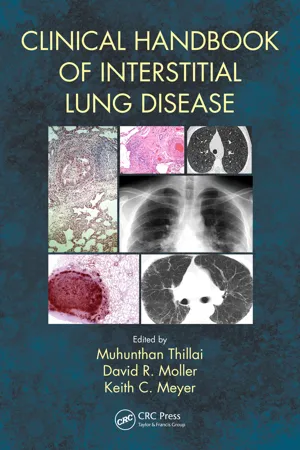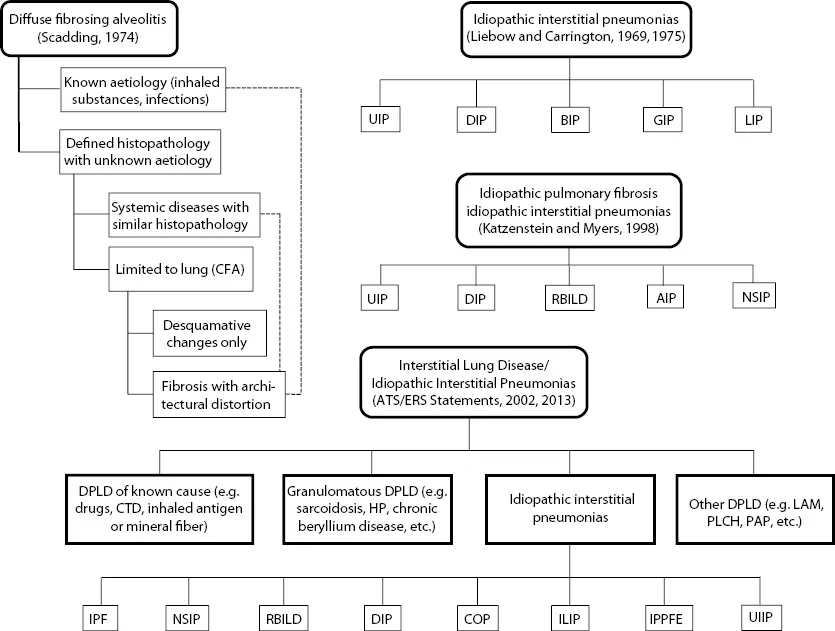
eBook - ePub
Clinical Handbook of Interstitial Lung Disease
- 529 pages
- English
- ePUB (mobile friendly)
- Available on iOS & Android
eBook - ePub
Clinical Handbook of Interstitial Lung Disease
About this book
This handbook provides clinical guidance to the practicing physician on the diagnosis and treatment of Interstitial Lung Diseases (ILD). A contributed work with invited chapters which draw on the knowledge and experience of recognised global leaders in respiratory medicine, it is authoritative, concise and portable and is intended for use in a fast-paced clinical setting. The book:
- offers practical tips and clear guidance for clinicians
- provides detailed explanations of the main therapeutic options for each individual ILD
- contains high-quality visuals, including radiology and histopathology of the most common as well as some of the rarer ILDs
- discusses individual ILDs and has topics common to all including critical care, lung transplantation and palliative care
- navigates clinicians through cases with decision making guidelines and algorithms
- includes appendices with international practice guidelines, sample patient information sheets and other helpful resources.
Emphasizing how to perform a thorough assessment of an ILD patient for accurate diagnosis and their subsequent effective management, this is both a gold standard text as well as a daily companion for physicians caring for ILD patients. A first-of-its-kind, it will become the go-to guide for all clinicians who manage patients with ILD.
Frequently asked questions
Yes, you can cancel anytime from the Subscription tab in your account settings on the Perlego website. Your subscription will stay active until the end of your current billing period. Learn how to cancel your subscription.
No, books cannot be downloaded as external files, such as PDFs, for use outside of Perlego. However, you can download books within the Perlego app for offline reading on mobile or tablet. Learn more here.
Perlego offers two plans: Essential and Complete
- Essential is ideal for learners and professionals who enjoy exploring a wide range of subjects. Access the Essential Library with 800,000+ trusted titles and best-sellers across business, personal growth, and the humanities. Includes unlimited reading time and Standard Read Aloud voice.
- Complete: Perfect for advanced learners and researchers needing full, unrestricted access. Unlock 1.4M+ books across hundreds of subjects, including academic and specialized titles. The Complete Plan also includes advanced features like Premium Read Aloud and Research Assistant.
We are an online textbook subscription service, where you can get access to an entire online library for less than the price of a single book per month. With over 1 million books across 1000+ topics, we’ve got you covered! Learn more here.
Look out for the read-aloud symbol on your next book to see if you can listen to it. The read-aloud tool reads text aloud for you, highlighting the text as it is being read. You can pause it, speed it up and slow it down. Learn more here.
Yes! You can use the Perlego app on both iOS or Android devices to read anytime, anywhere — even offline. Perfect for commutes or when you’re on the go.
Please note we cannot support devices running on iOS 13 and Android 7 or earlier. Learn more about using the app.
Please note we cannot support devices running on iOS 13 and Android 7 or earlier. Learn more about using the app.
Yes, you can access Clinical Handbook of Interstitial Lung Disease by Keith C. Meyer, Muhunthan Thillai, David R. Moller, Keith C. Meyer,Muhunthan Thillai,David R. Moller, Muhunthan Thillai, David R. Moller, Keith C. Meyer in PDF and/or ePUB format, as well as other popular books in Medicine & Medical Theory, Practice & Reference. We have over one million books available in our catalogue for you to explore.
Information
1
An overview of the classification and diagnosis of interstitial lung disease
Keith C Meyer
Historical background and evolution of terminology
Current classification systems for ILD
Idiopathic interstitial pneumonias
Genetics of ILD: Potential impact on classification and terminology
Current approach to making a confident ILD diagnosis
Summary
References
Historical background and evolution of terminology
Recognition of the existence of interstitial lung disease (ILD) dates back more than 100 years when Sir William Osler described ‘cirrhosis of the lungs’ and recognized the diversity of its forms and the difficulty of classifying these disorders (1). Various terminologies were coined over the span of the twentieth century as various leaders in the field described patients whose lungs displayed changes of interstitial inflammation and fibrosis. Hamman and Rich (1944) described four cases of rapidly progressive, diffuse alveolar wall thickening without identifiable cause, which led to use of the term, ‘Hamman–Rich syndrome’ for either acute-onset or chronic fibrotic ILD. Subsequently, diffuse pulmonary fibrosis was linked to forms of connective tissue disease (CTD) and other causes, such as exposure to organic or inorganic dusts and pneumotoxic drug reactions, but many forms remained unexplained by any associations. Terms such as ‘chronic idiopathic interstitial fibrosis’, ‘diffuse fibrosing alveolitis’ or ‘idiopathic pulmonary fibrosis’ were used to designate fibrotic ILD of unknown aetiology, and these disorders were thought to occur as a consequence of alveolar wall inflammation (‘alveolitis’). The term ‘diffuse fibrosing alveolitis’ was coined by Scadding (2) to describe widespread fibrotic change beyond the level of the terminal bronchioles, and Scadding subdivided entities according to known or unknown associations and patterns of fibrosis (Figure 1.1). Liebow and Carrington (3,4) published a classification system for chronic idiopathic interstitial pneumonias that was based on histopathologic changes; one of the five subgroups that they described was termed ‘usual’ interstitial pneumonia (UIP), and the Hamman–Rich syndrome was felt to be an acute form of UIP (Figure 1.1).

Figure 1.1Evolution of classification systems for interstitial lung disease and forms of idiopathic interstitial pneumonia. (Abbreviations: AIP = acute interstitial pneumonia; BIP = bronchiolitis interstitial pneumonia; CFA = cryptogenic fibrosing alveolitis; COP = cryptogenic organizing pneumonia; CTD = connective tissue disease; DIP = desquamative interstitial pneumonia; DPLD = diffuse parenchymal lung disease; GIP = giant cell interstitial pneumonia; HP = hypersensitivity pneumonia; ILIP = idiopathic lymphoid interstitial pneumonia; IPF = idiopathic pulmonary fibrosis; IPPFE = idiopathic pleuropulmonary fibrosis; LAM = lymphangioleiomyomatosis; NSIP = non-specific interstitial pneumonia; PLCH = pulmonary Langerhans cell histiocytosis; RBILD = respiratory bronchiolitis interstitial lung disease; UIIP = undifferentiated interstitial pneumonia; UIP = usual interstitial pneumonia.)
The classification systems proposed by Scadding or Liebow and Carrington were quite similar, but clinicians tended to overlook histopathologic variations and termed ‘chronic idiopathic fibrosing ILD’ as ‘cryptogenic fibrosing alveolitis’ (Europeans) or ‘idiopathic pulmonary fibrosis’ (United States). Katzenstein and Myers (5) re-examined Liebow’s classification system and refined the histopathology-based system by adding two new categories (non-specific interstitial pneumonia [NSIP] and respiratory-bronchiolitis-associated ILD [RBILD]) while revising/retaining some of Liebow’s categories (UIP and desquamative interstitial pneumonia [DIP]): acute interstitial pneumonia (AIP) was coined as a term for the Hamman–Rich syndrome (Figure 1.1). Their scheme recognized giant cell interstitial pneumonia (GIP) as caused by hard-metal exposure and considered lymphoid interstitial pneumonia (LIP) as a lymphoproliferative disorder, while bronchiolitis interstitial pneumonia (BIP) was recognized as an intraluminal (rather than interstitial) process that could take the form of organizing pneumonia (aka bronchiolitis obliterans organizing pneumonia [BOOP]) or diffuse alveolar damage (DAD). They also correlated their histopathologic pattern-based classification system with clinical features and natural history.
With the evolution of ongoing clinical and pathologic investigations of ILD from the late twenti...
Table of contents
- Cover
- Half Title
- Title Page
- Copyright Page
- Dedication
- Contents
- Foreword
- Contributors
- Introduction
- 1. An overview of the classification and diagnosis of interstitial lung disease
- 2. Histopathology of interstitial lung disease: A pattern-based approach
- 3. Using thoracic imaging to diagnose ILD
- 4. Genetics and genomics of idiopathic pulmonary fibrosis
- 5. Clinical evaluation of the patient with suspected ILD
- 6. Role of invasive testing in ILD diagnosis
- 7. General principles of ILD diagnosis and management
- 8. Idiopathic pulmonary fibrosis: Epidemiology, natural history and pathophysiology
- 9. Idiopathic pulmonary fibrosis: How should a confident diagnosis be made?
- 10. Management of idiopathic pulmonary fibrosis
- 11. Hypersensitivity pneumonitis
- 12. Idiopathic interstitial pneumonias other than idiopathic pulmonary fibrosis
- 13. Eosinophilic interstitial lung disorders
- 14. Interstitial lung disease associated with connective tissue disorders
- 15. Pulmonary sarcoidosis
- 16. Sarcoidosis extra-pulmonary manifestations
- 17. Smoking and interstitial lung disease
- 18. Drug-induced and iatrogenic interstitial lung disease
- 19. Occupation-related ILD
- 20. Pulmonary vasculitis and alveolar haemorrhage syndromes
- 21. Lymphangioleiomyomatosis and other cystic interstitial lung diseases
- 22. Pulmonary alveolar proteinosis
- 23. Rare forms of interstitial lung disease
- 24. Childhood ILD
- 25. Understanding the role of co-morbidities in interstitial lung diseases
- 26. Lung transplantation for ILD
- 27. Diagnosis and management of critical illness in patients with interstitial lung disease
- Index